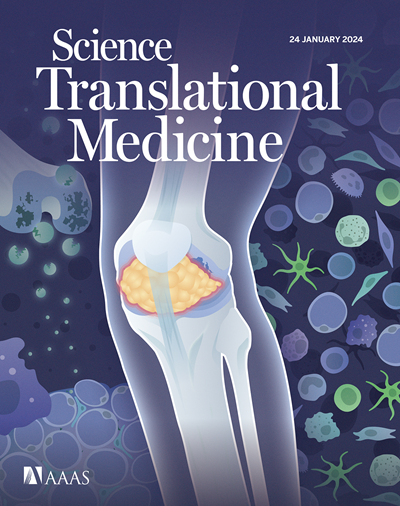Inhibition of NR2F2 restores hormone therapy response to endocrine refractory breast cancers
IF 15.8
1区 医学
Q1 CELL BIOLOGY
引用次数: 0
Abstract
Endocrine resistance is frequently encountered in estrogen receptor–positive (ER+) breast cancer, often because of somatic mutations such as neurofibromin 1 (NF1) loss. The mechanisms by which ER-directed proliferation is lost in such cases are unknown, limiting the potential use of additional endocrine treatments. Here, we performed CRISPR-Cas9 knockout (KO) screens and found that nuclear receptor subfamily 2 group F member 2 (NR2F2), an orphan nuclear receptor, was essential for NF1 loss–induced endocrine resistance. Induction of NR2F2 was observed in ER+ cell line models and patient samples and occurred via activation of the mitogen-activated protein kinase (MAPK) pathway upon NF1 loss or other MAPK pathway genetic alterations. Mechanistically, increased NR2F2 orchestrated a repressed ER transcriptional program by repartitioning the ER cistrome, altering the balance of its associated transcriptional coregulators, and modifying global chromatin accessibility. Accordingly, genetic depletion or pharmacologic inhibition of NR2F2 restored sensitivity to hormone therapies in multiple models, including ER+ cell lines, patient-derived xenografts, and patient-derived organoid-based xenografts harboring diverse endocrine-resistance mechanisms such as NF1, AT-rich interactive domain-containing protein 1A (ARID1A), phoshatase and tensin homolog (PTEN) loss, or Kirsten rat sarcoma virus (KRAS) overexpression. Together, these findings underscore NR2F2 as a critical modulator of the hormone response pathway and suggest its inhibition as a promising strategy to overcome endocrine resistance in breast cancer.
抑制NR2F2可恢复内分泌难治性乳腺癌的激素治疗反应
雌激素受体阳性(ER+)乳腺癌中经常遇到内分泌抵抗,通常是由于体细胞突变,如神经纤维蛋白1 (NF1)丢失。在这种情况下,内质网定向增殖丧失的机制尚不清楚,这限制了额外内分泌治疗的潜在应用。在这里,我们进行了CRISPR-Cas9敲除(KO)筛选,发现核受体亚家族2组F成员2 (NR2F2),一个孤儿核受体,对NF1损失诱导的内分泌抵抗至关重要。在ER+细胞系模型和患者样本中观察到NR2F2的诱导,并且在NF1丢失或其他MAPK途径遗传改变时,通过激活丝裂原活化蛋白激酶(MAPK)途径发生。从机制上讲,NR2F2的增加通过重新划分内质网,改变其相关的转录共调节因子的平衡,并改变整体染色质可及性来协调被抑制的内质网转录程序。因此,基因缺失或药物抑制NR2F2恢复了多种模型对激素治疗的敏感性,包括ER+细胞系、患者来源的异种移植物和患者来源的基于器官的异种移植物,这些移植物具有不同的内分泌抵抗机制,如NF1、富含at的相互作用结构域蛋白1A (ARID1A)、磷光酶和紧张素同源物(PTEN)缺失或Kirsten大鼠肉瘤病毒(KRAS)过表达。总之,这些发现强调了NR2F2作为激素反应途径的关键调节剂,并表明其抑制是克服乳腺癌内分泌抵抗的一种有希望的策略。
本文章由计算机程序翻译,如有差异,请以英文原文为准。
求助全文
约1分钟内获得全文
求助全文
来源期刊

Science Translational Medicine
CELL BIOLOGY-MEDICINE, RESEARCH & EXPERIMENTAL
CiteScore
26.70
自引率
1.20%
发文量
309
审稿时长
1.7 months
期刊介绍:
Science Translational Medicine is an online journal that focuses on publishing research at the intersection of science, engineering, and medicine. The goal of the journal is to promote human health by providing a platform for researchers from various disciplines to communicate their latest advancements in biomedical, translational, and clinical research.
The journal aims to address the slow translation of scientific knowledge into effective treatments and health measures. It publishes articles that fill the knowledge gaps between preclinical research and medical applications, with a focus on accelerating the translation of knowledge into new ways of preventing, diagnosing, and treating human diseases.
The scope of Science Translational Medicine includes various areas such as cardiovascular disease, immunology/vaccines, metabolism/diabetes/obesity, neuroscience/neurology/psychiatry, cancer, infectious diseases, policy, behavior, bioengineering, chemical genomics/drug discovery, imaging, applied physical sciences, medical nanotechnology, drug delivery, biomarkers, gene therapy/regenerative medicine, toxicology and pharmacokinetics, data mining, cell culture, animal and human studies, medical informatics, and other interdisciplinary approaches to medicine.
The target audience of the journal includes researchers and management in academia, government, and the biotechnology and pharmaceutical industries. It is also relevant to physician scientists, regulators, policy makers, investors, business developers, and funding agencies.
 求助内容:
求助内容: 应助结果提醒方式:
应助结果提醒方式:


